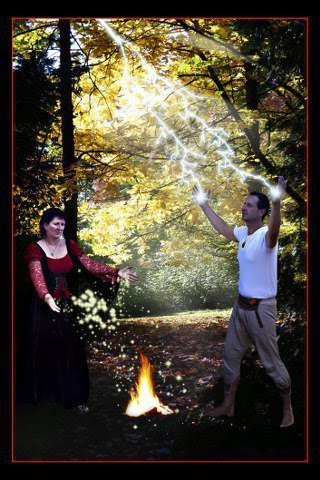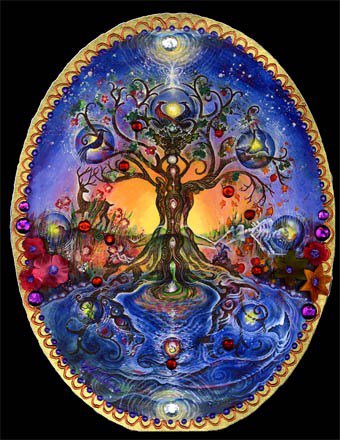It's been a while since my last post and much has happened which I will share here,in time.
The label,"
Pagan" was a derogatory term, first used by the Romans to describe the country hicks,ignorant and uneducated peasants,who still practiced the old ways.These people called Pagans, refused to accept the new God/s,advances in technological and medicine.The local ancient Gods were still honoured and traditional remedies were still used to treat all ailments.These people lived as their Ancestors lived and were determined people.Later, the label was also used for non Abrahamic religions. Which is anyone who does not follow one of the three,Judaism,Islam and Christian. Abrahams club was relatively small compared to the diverse Indigenous Peoples of Europe and so the need arose to vilify anyone who wasn't a member.
The term, "Pagan"was always used condescendingly to insult country folk who refused to accept their own Faith.
Pretty sad origins, I think,but how this label has become something that many now proudly identify themselves is an interesting turn of events. People now even identify themselves as a,"Witch",who were also villified,feared,despised and murdered.Some Witches were murdered but most were accused Innocents.See, the definition for a Witch was anyone who practised the ,"Satanic", arts of herbalism,midwifery,spell casting and even homosexuality!(The term,"faggot" defined as a bundle of sticks used to a fire.Homosexuals weren't considered clean enough to even have a pole to be burnt on and were simply thrown on with the faggots.).Anyone that had an unusual mole or upset a neighbour could also be accused of secretly practising witchcraft.Natural climatic events like cold snaps which make crops fail have incited many Witch hunts but it might surprise you to know that it was the common folk taking the church law into their own hands,that even caused the Church leaders to worry.
It is funny that Pagans were ridiculed for being ignorant peasants and Christians incited a very different kind of ignorance that infected so many.Ignorance that taught people that People with disabilties and mental health were possessed, Mid wives, who bought life into this world,Herbalists and other Healers were Satans servants, and any sort of bad weather was blame on the spell Casters! What a crazy and ignorant world it would have been back then!
Instead of,"Pagan", For want of a better word,in this blog, I have chosen the term,"Earthies", to describe the diverse group indigenous Peoples from across this wonderful planet.Just as we have:
-PaleoPagans,
-MesoPagans
- and NeoPagans,
I shall refer to them now as Paleo Earthies,Meso Earthies and Neo Earthies.Instead of Pagansm,I think Earthism is a more appropriate adjective because,I believe, it better describes the Faith practised and way of life of Paleolithic Peoples.
The greater majority of people who ever lived on this planet,were Earthies.Our distant Ancestors practiced what we call Paleo Earthism.I believe that the Paleo Earthies were polytheists and did have some male Gods however, the vast majority of archeological finds by Marija Gimbutas,show evidence of a strong Goddesses culture.They came from the mists of time,up to 40 thousand years ago.Some civilisations from this time have survived till today,and some only just managed to survive with scattered remnants.To name a few surviving Paleo Earthies tribes,we have:
*some tribes of Australian Aboriginals,
*Some tribes of the North American Indians,
*African Pygmy tribes,
*Some Druidic traditions,
*Siberian Shamans,
Meso Earthies are Peoples who have taken the surviving knowledge and traditions from Paleo Earthies. Like their Paleo Cousins,Meso Earthies are also polythesists who had many Gods of both genders and generally from the one pantheon. Most traditions have been been influenced by Abrahamic religions.Some were deliberate,some incidental and some forced. For example,
*Hinduism was influenced with the migration of Islamists.
*Spiritualism was influenced greatly by all of the Abrahamic religions.
*Freemasonry,Rosicrucian,African Faiths of Voodoo and Santeria have been blended with Christian ideologies.
*Satanists also, who originally honoured the Egyptian God Set, have today, become Christian heretics.
*British Traditional Witchcraft has even had some Christian influences.
*Romuva in Lithuania has had minimal influence by the Catholic Church because of their late conversion.
Meso Earthies,reconstruct the ways of their Ancestors in order to revive and continue ancient Faith and culture as best as they can,however some movements can be rascist,homophobic,separatist and center on the family.An example would be the Nazism and some sects of the Odinism.

Neo Earthies really took off in the 1960s with the rise of spirituality in the Hippy era. Earthies in this movement are polythesists also but many different pantheons. Many people understand that New Age movement is simply,Old Age,rehashed. Much of the New Age movement is eclectic in their beliefs and practises and have also had influences from Abrahamic religions.Unfortunately ,without permission,many of the indigenous practices, are irreverently stolen from several different Indigenous Paleo Earthies.Many of the customs have been altered,adapted,distorted and blended with other customs.I don't like this idea and find it a little disrespectful to the indigenous people and their own traditions.If asked,I'm sure they would disapprove of the distortion of their time honoured customs.In saying that,many of these customs are common across the globe,such as smudging by North American Indians,European and Baltic Peoples to smoking Rites of the Australian Aboriginals.Neo Earthies is a collective term used for People who identify themselves as ecclectic in Faiths.Many are involved with ecological activism in some form or another. Neo Earthism has made great strides to equality of the genders with the rise of Feminism.Women are on their way to having equal opportunities and rights,in much of the western world,but there is still a long way to go.Especially in Islamic countries! There is a strong feminist and separatist movement amongst the Neo Earthies.Reviving the Goddess which,I believe, hearkens back to the Paleo Earthies which I believe,must evolve from feminism to Humanism.. .

Anyway I digress,we are all Earthlings whether we are Paleo,Meso or Neo Earthies! I consider myself to be a Meso Earthie who,like most people,found my Faith initially through the Neo Earthism.I am an adherent of Romuva but do not mind participating in other rituals and customs if invited.I respect all Peoples Faith whether it be Neo,Meso or Neo.I am lucky to have been born in Australia.I have been privileged to have the freedom to live and learn about my identity as an Earthling and my true Faith, without fear of persecution.
So,why do people of indigenous Faiths like to identify themselves as Pagans and Witches?I've given this a great deal of thought.Ethnic people now call themselves wogs?,Homosexuals call themselves queers,fags,poofs,dykes,etc? And Earthies call themselves Pagans and Witches? when all these terms have been used to vilify,persecute and bully?
A: I believe that it is a way of uniting historically disenfranchised people and metaphorically blowing a raspberry at our persecutors by saying that these hurtful labels are no longer hurtful and we are proud of who we are.Just to make the point clear,we use the same terms.Does anyone else have any ideas?














.jpg)





